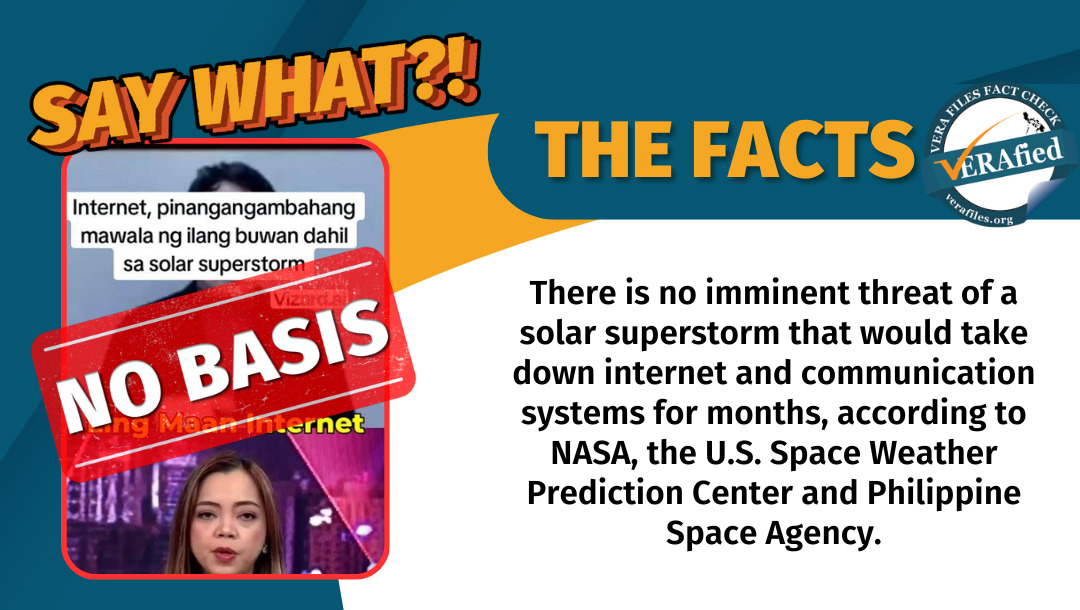Videos circulating on Instagram, Facebook (FB) and TikTok are claiming that a solar superstorm would cause a global internet outage that would last for months. This has no basis.
There are currently no warnings from the National Aeronautics and Space Administration (NASA) of the United States or its Space Weather Prediction Center (SWPC) about an imminent and powerful solar storm that could hit the Earth and destroy communications infrastructure.
The SWPC forecasted minor solar and geomagnetic storms from Dec. 7 to 9 but this is just expected to cause a slight interruption on radio signals.
In a Dec. 4 email to VERA Files Fact Check, Dominic Guaña, Supervising Science Research Specialist from the Philippine Space Agency (PhilSA), said that while solar activity is projected to increase in the next four years, there is not enough evidence to conclude that it would cause an internet apocalypse:
“There is indeed a strong chance that a localized solar maximum may occur in the said years. This might affect power systems, spacecrafts, and communication signals among others. However, it is still hard to rule in an internet apocalypse at this time.”
Guaña added that since the birth of the internet in the 1980s, the earth has experienced “three very active phases of the sun and neither of [these] has caused internet apocalypse.”
 The videos, which showed a Nov. 14 report from TV5 program Frontline Pilipinas, only discussed that a solar storm as powerful as the one recorded in 1859 could potentially take out the internet for months.
The videos, which showed a Nov. 14 report from TV5 program Frontline Pilipinas, only discussed that a solar storm as powerful as the one recorded in 1859 could potentially take out the internet for months.
The same report, which also appeared in Fox News Weather, said that scientists are currently developing an early warning system that could send signals 18-24 hours before a coronal mass ejection (CME) hits the Earth. According to the SWPC, CMEs are “large expulsions of plasma and magnetic field from the Sun.”
CMEs produce solar storms which, if powerful enough, could damage the earth’s electric grid, satellites and the internet.
In 1859, the Carrington Event, known as the most intense solar storm in recorded history, had broken down telegraph systems across Europe and North America, with some wires even reported to have caught fire.
In a Dec. 1 interview with VERA Files Fact Check, Lordnico Mendoza, weather specialist from the Philippine Atmospheric Geophysical and Astronomical Services Administration (PAGASA), also clarified that today’s power and communication systems are better equipped to handle solar storms:
“Marami na tayong power grids, marami na tayong generators, marami na tayong satellite communications so, kung may mangyari mang solar storm, at least we are prepared. Kaya siyang i-predict kung kailan siya darating sa earth. So pwede na natin siyang mamitigate kumbaga o ma-lessen ‘yung kanyang effect sa atin. So makakapag-prepare na tayo in advance.”
(We now have several power grids, generators and satellite communications so, if a solar storm happens, at least we are prepared. We can predict when it will hit the earth so we can mitigate or lessen its effect. We can prepare in advance.)”
Mendoza also advised the public to check for updates or advisories about solar storms from reputable sources such as NASA, PhilSA or PAGASA.
In 2006, NASA said a solar storm affected the Earth which interfered with GPS signals. In 2012, a solar storm as strong as the Carrington Event had missed the Earth.
The videos received around 4.5 million views on Instagram, 3.8 million views on TikTok and 27,000 views on FB.
Have you seen any dubious claims, photos, memes, or online posts that you want us to verify? Fill out this reader request form or send it to VERA, the truth bot on Viber.
(Editor’s Note: VERA Files has partnered with Facebook to fight the spread of disinformation. Find out more about this partnership and our methodology.)


